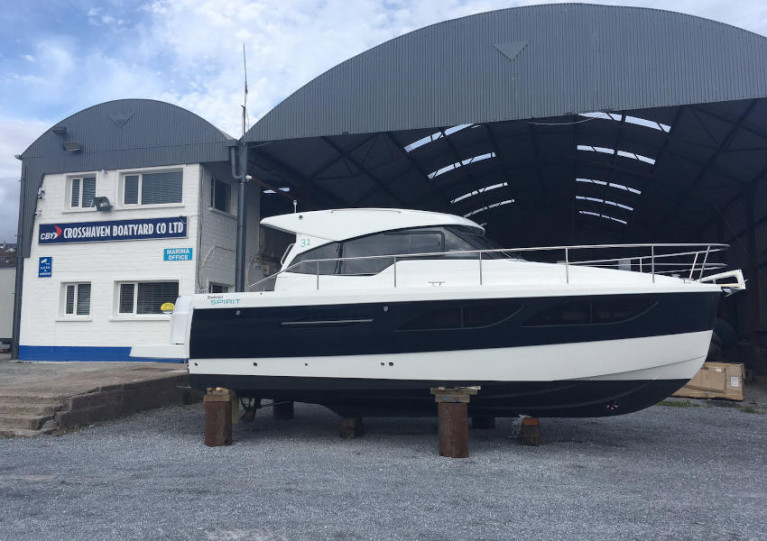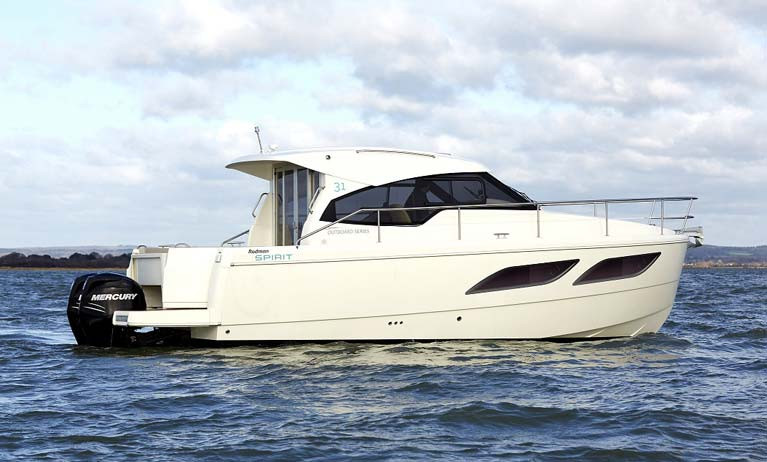Displaying items by tag: Rodman
Crosshaven Boatyard Launch Rodman's New 690 Ventura CC at Southampton
Rodman's Irish agent, Hugh Mockler of Crosshaven Boatyard, is sharing news of the world launch of a new range from the Rodman Shipyard at the Southampton International Boat Show 2022 this week, where they will have the first model, the Rodman 690 Ventura CC on display.
This new range of outboard boats, from 6-8m in length, will have models available in different deck versions; open with centre console, open with forward cabin and hard top.
In designing this range, Rodman set out to provide a boat that would be accessible to all, aiming to both attract a younger client who might be new to boating, or who wants a sporty boat that compliments an active lifestyle, as well as satisfying the more traditional customer who values comfort and safety.
"The new Rodman 690 Ventura CC is the perfect choice for an affordable day boat that is well suited to all coastal and inland waters across the UK and Ireland, with maximum comfort, great features and the excellent seakeeping expected from Rodman boats", Irish agent Hugh Mockler told Afloat.
The new Rodman 690 Ventura CC will be on display on the Marina at the Southampton International Boat Show 2022, on berth M151. This boat has a 6.5 m hull length and 7.7 m length overall, with a 2.55 m beam. Category C for 6 people (or D for 8) the boat can be fitted with a single outboard engine up to 200hp, and the boat on display at the show has reached speeds of almost 40 knots in sea trials.
 On deck on the Rodman 690 Ventura CC, you will find two distinct areas - the aft cockpit and the forward bow. The cockpit has a rear seat option, which can be completed with a side module and a table. The helm and co-pilot seats will also swivel to face your guests. There is the option of covering this area with an extendable bimini-type sun canopyForward, this new model also offers a second seating area, which can be equipped with cushions and seats, another table and there is also the possibility of turning the entire surface into a solarium. This area can also be covered with a fixed sun canopy. Safe and comfortable movement between the two areas is guaranteed by wide, identical lateral passageways on both sides, one of the hallmarks of all Rodman boats
On deck on the Rodman 690 Ventura CC, you will find two distinct areas - the aft cockpit and the forward bow. The cockpit has a rear seat option, which can be completed with a side module and a table. The helm and co-pilot seats will also swivel to face your guests. There is the option of covering this area with an extendable bimini-type sun canopyForward, this new model also offers a second seating area, which can be equipped with cushions and seats, another table and there is also the possibility of turning the entire surface into a solarium. This area can also be covered with a fixed sun canopy. Safe and comfortable movement between the two areas is guaranteed by wide, identical lateral passageways on both sides, one of the hallmarks of all Rodman boats
This new model is completed by a comfortable console interior, with comfortable access and wide stowage space with the option to fit a chemical toilet.
Crosshaven Boatyard Unveil New Rodman Boats at Southampton Boat Show 2021
After a year's break, Hugh Mockler of Crosshaven Boatyard from Cork Harbour is delighted to be presenting a three boat Rodman line up at the Southampton Boat Show that runs until the 18th September, with representatives from each of Rodman's leisure boat ranges; the Rodman Spirit 31 Outboard, Rodman 1090 Evolution and Rodman Muse 44. The boats can be found on the water, berths M139, M141 and M143.
All three boats showcase some of the latest updates from the Rodman shipyard, all benefitting from large hull windows, improving the space and light in the cabins.
The Rodman 1090 Evolution is the first of the new Evolution range from Rodman. From the Fisher & Cruiser range, the proven Rodman 1040 hull has been utilised to create the new Rodman 1090 Evolution, with a completely new superstructure featuring a useful side door. With all the benefits you can expect from a Rodman, including deep walk around side decks, large cockpit space, the strength of build and excellent seakeeping, but now in a modern package!
The Outboard version of the Rodman Spirit 31 will be presented at the show. The boat displayed at the show features new materials and colour schemes, giving the model a fresh look. You can expect excellent performance from her twin 200hp Suzuki outboards, with max speed pushing 40 knots. The Rodman Spirit 31 is available with inboard or outboard power - not sure which is best for you? Come and see our staff on the boat and ask for one of our 'Inboard or Outboard' leaflets, presenting all the information you need to know to work out which option is best for your boating adventures.
The stunning Rodman Muse 44 on the water this year showcases larger saloon windows compared to previous models, and this particular boat has a whole host of exciting extras to see, including a hydraulic bathing platform and underwater (disco!) lights. This three cabin 44 footer is on IPS drives, making manoeuvring a doddle and offering improved fuel economy over shaft drive.
The Rodman boats will be staffed by RBS Marine, the importer for Rodman boats for the UK, Ireland and Channel Islands, and also on hand will be staff from local Rodman representatives from Ireland (Crosshaven Boatyard).
Crosshaven Boatyard Unwraps New Rodman Spirit 31
Crosshaven Boatyard — the Irish agents for Rodman Boats — yesterday took the wrapping off a new Rodman Spirit 31 at their Cork Harbour yard and marina.
The hardtop inboard model comes with 320HP Volvo diesel engine, slightly different from the one that was shown with the Spanish brand’s latest range at boot Düsseldorf earlier this year.
For more details, contact Crosshaven Boatyard at 021 483 1161 or email [email protected]
New #Rodman #Spirit 31 with a 320HP #Volvo diesel unwrapped today in #Crosshaven #Boatyard Thank you Rodman ?? for your quality #boat ?? with @RodmanBoats @RBSMARINE @AfloatMagazine pic.twitter.com/4CN5MZQxqY
— Crosshaven Boatyard (@CrosshavenBY) July 14, 2020
Crosshaven Boatyard on Board for Rodman's Return to Boot Dusseldorf
This is the first time in some years that Rodman have been to Boot Dusseldorf, and now is a great time for them to make a comeback as the show is anticipated to be bigger than ever.
Their stand, B19 in Hall 4 will have on display the newest developments to come from the factory, with two completely new models and two models showcasing recent facelifts and there will be an Irish presence on the stand with Hugh Mockler of Crosshaven Boatyard from Cork Harbour.
The new Rodman 33 Offshore will have her official international launch at Dusseldorf, and the new Rodman 1090 Evolution, launched last year at Southampton Boat Show, will also be on display. Then, two more of Rodman’s outboard models will be on the stand, the Rodman Spirit 31 Outboard and the Rodman 890 Ventura- with both models having new hull windows and refreshed interiors to show off.
This is the first time RBS Marine have attended Boot Dusseldorf, and Ben Stevens is looking forward to being on the stand for the duration to meet visiting clients from the UK. It will be wonderful to be joined by Hugh Mockler from Crosshaven Boatyard as Ben and Hugh look to develop Rodman within the Irish market together. Rodman boats are renowned for their strength of build and seakeeping, making them ideal for the demands of boating in Ireland’s waters.
Rodman Spirit 31
Outboard – boating, the way you want it! The Rodman Spirit 31 (pictured above) is available as a hardtop or open, with inboard or outboard power, and with single or twin engines. At Dusseldorf the Spirit 31 Hard Top outboard will be on display, which features the unique sliding transom seats unique to the model which allow access to the port or starboard sides of the cockpit. The outboard version features a double berth to the mid-ship, with a separate forward cabin and separate heads. Ideal for families or couples as a comfortable weekender, and lots of fun with the outboard engines giving a thrilling performance at your fingertips.
Rodman 33 Offshore
 Rodman 33 Offshore
Rodman 33 Offshore
The first crossover seen between Rodman’s commercial department and their leisure range, the outboard-powered Rodman 33 Offshore is based on the hull of their formidable Rodman 33 Patrol. With the Patrol version used for fast intervention missions by government agencies, the 33 Offshore is more for chasing the sunshine and the fishing than the baddies! With speeds of up to 45 knots, it’s a thrilling ride to your destination or fishing grounds, and you can experience the joy of alfresco dining with the optional BBQ galley unit aft of the helm. For more than quick trips, there is a separate heads compartment and double berth cabin with hanging storage.
Rodman 1090 Evolution
 Rodman 1090 Evolution
Rodman 1090 Evolution
Rodman’s Fisher & Cruiser range has really captured the hearts of boaters in the UK and Ireland over the last 20 years, and the Rodman 1090 Evolution represents a new era for this popular range. The 1090 Evolution is based on the proven 1040 hull and retains the features we know and love like the wide walk-around side decks and large cockpit space. However, the 1090 Evolution brings forward a whole host of exciting and modern updates including large hull windows, side door, sliding saloon doors and fresh interior materials. The boat is available as a hardtop (with a large electric sunroof as standard) or flybridge and is on inboard shaft driven Volvo D4 engines with a choice of 270 or 300hp.
Rodman 890 Ventura
 Rodman 890 Ventura
Rodman 890 Ventura
Rodman’s entry-level outboard model, the 890 Ventura is the ideal boat if you want to compromise your fishing and cruising desires. Can be specified with a fishing pack (to include rod holders, tackle storage unit) or cruising pack (sunbathing areas, cockpit tables) or perhaps a bit of both to keep everyone happy! Excellent all-round visibility from the wheelhouse and the 890 Venture now benefits from new hull windows which let more light into the cabins, increasing the feeling of space below deck.

























































